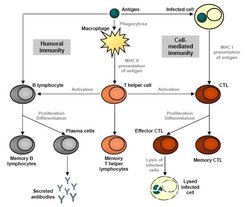Particulate formulation of influenza virus antigen
Strategies to control seasonal influenza outbreaks are mainly centered on prophylactic vaccinations in conjunction with antiviral treatments. Vaccines introduce a primed state in the vaccinated person or animal. Therefore following exposure to the particular pathogen causes a fast secondary immune response. This adaptive immunity leads to an accelerated elimination of the pathogens and protection from clinical disease. There are two types of adaptive immune responses, shown in Fig.1: humoral and cell-mediated immunity (CMI). CMI is the effector function of T lymphocytes and serves as the defense mechanism against pathogens, which survive within phagocytes or infect nonphagocytic cells [1]. Efficient vaccines should elucidate both humoral and CMI.

Current inactivated influenza [2] vaccines consist of highly purified whole viruses or viral components, e.g. membrane fractions (split vaccines) or haemagglutinin (HA) protein (subunit vaccines), in a well defined formulation. Most commercially available vaccines are adjuvanted to increase their potency [3]. Adjuvants (derived from the Latin adjuvare, meaning to help) are structurally heterogeneous foreign materials introduced with the antigen of the virus to enhance its immunogenicity. By now a variety of adjuvants inducing humoral and/or cellular immunity is known including killed bacteria, bacterial products, liposomes, aluminum, and emulsions.
The challenge is to produce safe influenza vaccine formulations elucidating a highly potent immune response. An increased potency would additionally reduce the antigen requirements per vaccine dose and therefore enable the manufacturers of influenza vaccines to get one step closer to satisfy the high demands of the market without increasing production capacity. One possibility to achieve an efficacy increase could be the packaging of influenza HA via nanoparticles together with specific immunostimulating factors as e.g. the cytokines INFgamma;, and IL-12 [4,5].
An example for nanoparticles with adjuvant activity, which are able to promote both cell-mediated and humoral immunity, is a so called immunostimulating complex (ISCOM) [6]. ISCOMs are cage-like particles (Fig. 2) with a diameter of typically 40 nm consisting of antigen, cholesterol, phospholipid and saponin, an active glycoside extracted from the bark of the South American tree Quillaja saponaria. These or similar structures could also be produced containing immunostimulating factors as mentioned above in addition to the antigen HA.
![Fig 2. Electron micrograph of ISCOMs [7]](/3368556/original-1518440819.jpg?t=eyJ3aWR0aCI6MjQ2LCJvYmpfaWQiOjMzNjg1NTZ9--8f41340a21bea434222ce6fbc3ef03994cdfb1df)
Aim of our work
This project is dealing with the incorporation of purified HA of Madin Darby canine kidney (MDCK) cell-derived influenza viruses into nanoparticles do produce formulations, which are able to induce a broad immunity. Structural characterization of the particles as well as safety and efficacy studies in terms of immunogenicity compared to classical influenza vaccine will be done.
Literature
[1] Janeway CA Jr, Travers P, Walport M, Shlomchik MJ, 2005. Immunobiology: the immune system in health and disease. Garland Science Publishing, New York. ISBN: 0-8153-4101-6
[2] Nicholson KG, Webster RG, Hay AJ, 1998. Textbook of Influenza. Blackwell Science Ltd., Oxford. ISBN: 0-6320-4803-4
[3] Schijns VEJC, O'Hagan DT, 2005. Immunopotentiators in Modern Vaccines. Elsevier Academic Press Inc., Amsterdam. ISBN: 0-12-088403-8
[4] Boyaka PN, McGhee JR, 2001. Cytokines as adjuvants for the induction of mucosal immunity. Advanced Drug Delivery Reviews 51, 71-79
[5] O'Garra A, 1998. Cytokines Induce the Development of Functionally Heterogenous T Helper Cell Subsets. Immunity 8, 275-283
[6] Sanders MT, Brown LE, Deliyannis G, Pearse MJ, 2005. ISCOMTM-based vaccines: The second decade. Immunology and Cell Biology 83, 119-128
[7] Brügmann M, Drommer W, Reichl U, Boge A, 1997. Iscom (Immuno Stimulating Complex)-Vaccine of equine influenza virus transmission electron microscopical investigation and literature review. Deutsche tierärztliche Wochenschrift 104, 196-202
Interconnections with other projects of Bioprocess Engineering
Coupled Processes:
Influenza Vaccine Production in Microcarrier Systems
Analysis of Glycosylation of the Influenza A Virus Hemagglutinin
Downstream Processing and Chromatographic Methods
Downstream Processing of Influenza Virus
Affinity Chromatography of Influenza Virus
Interconnections with other research groups
Projects of Physical and Chemical Process Engineering (Prof. Dr.-Ing. K. Sundmacher )

![Fig 2. Electron micrograph of ISCOMs [7] Fig 2. Electron micrograph of ISCOMs [7]](/3368556/original-1518440819.jpg?t=eyJ3aWR0aCI6MzQxLCJmaWxlX2V4dGVuc2lvbiI6ImpwZyIsIm9ial9pZCI6MzM2ODU1Nn0%3D--c5333d816e2996ff75d833a39a51bdbb421f376a)